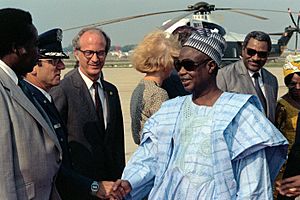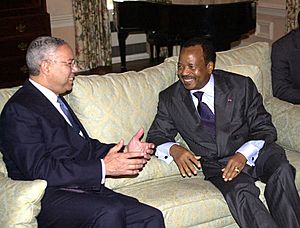Paul Biya facts for kids
Quick facts for kids
Paul Biya
|
|
|---|---|
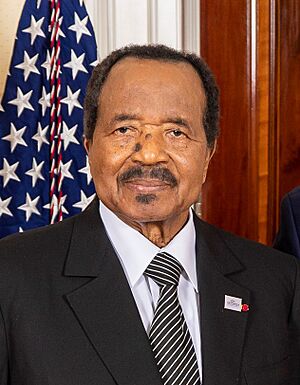
Biya in 2022
|
|
| 2nd President of Cameroon | |
| Assumed office 6 November 1982 |
|
| Prime Minister | Bello Bouba Maigari Luc Ayang Sadou Hayatou Simon Achidi Achu Peter Mafany Musonge Ephraïm Inoni Philémon Yang Joseph Ngute |
| Preceded by | Ahmadou Ahidjo |
| 5th Prime Minister of Cameroon | |
| In office 30 June 1975 – 6 November 1982 |
|
| President | Ahmadou Ahidjo |
| Preceded by | Office re-established; Simon Pierre Tchoungui and Salomon Tandeng Muna (1972) |
| Succeeded by | Bello Bouba Maigari |
| Personal details | |
| Born |
Paul Barthélemy Biya'a bi Mvondo
13 February 1933 Mvomeka'a, then part of French Cameroon |
| Political party | RDPC |
| Spouses |
|
| Children | 3, including Franck and Brenda |
| Education | National School of Administration, Paris Institute of Political Studies, Paris |
| Signature | |
Paul Biya (born Paul Barthélemy Biya'a bi Mvondo on 13 February 1933) is a Cameroonian politician. He has been the second president of Cameroon since 1982. Before becoming president, he served as the fifth prime minister from 1975 to 1982.
As of 2025, Paul Biya is one of the longest-serving presidents in Africa. He is also one of the longest-serving non-royal national leaders in the world. He is currently the oldest head of state globally.
Biya quickly rose through government ranks in the 1960s. He became Secretary-General of the Presidency and then prime minister. He took over as president when Ahmadou Ahidjo unexpectedly resigned in 1982. Biya then worked to strengthen his power.
In the 1980s, Biya introduced some political changes within a one-party system. Later, in the early 1990s, he allowed multiparty politics due to public pressure. He won the 1992 presidential election with 40% of the votes. He was re-elected in 1997, 2004, 2011, and 2018. Some people, including opposition politicians, have raised concerns about the fairness of these elections.
Contents
Early Life and Education
Paul Biya is from the Beti ethnic group. He was born in the village of Mvomeka'a in what is now the South Region of Cameroon.
He attended school in Yaoundé, Cameroon, and then in Paris, France. He studied at the Lycée Louis-le-Grand and the École Nationale de la France d'Outre-Mer. In 1961, he earned a diploma in public law.
Early Career in Government
After Cameroon gained independence in the 1960s, Biya began working in government. He quickly became an important figure under President Ahmadou Ahidjo.
In January 1964, he became the director of the Cabinet for the Minister of National Education. By January 1968, he was named Secretary-General of the Presidency. He continued to rise, becoming a minister in August 1968 and a minister of state in June 1970.
Leadership Roles
Becoming Prime Minister
In 1972, Cameroon became a unitary state. On 30 June 1975, President Ahidjo appointed Biya as prime minister.
A new law in June 1979 stated that the prime minister would become president if something happened to the current president. Ahidjo unexpectedly resigned on 4 November 1982, citing health reasons. Biya then became president two days later, on 6 November.
Paul Biya's Presidency
It was a surprise that Biya, a Catholic from the south, was chosen by Ahidjo, a Muslim from the north, to be his successor. Biya's father wanted him to become a priest, but Biya was expelled from Catholic school at age 16.
After Biya became president, Ahidjo remained the head of the ruling party, the Cameroon National Union (CNU). Biya was elected as the party's vice-president. However, a disagreement grew between Biya and Ahidjo in 1983. Ahidjo moved to France and criticized Biya publicly.
After Ahidjo resigned as CNU leader, Biya took over the party on 14 September 1983. In November 1983, Biya announced that the next presidential election would be held earlier than planned, in January 1984. He was the only candidate and won almost all the votes.
In February 1984, Ahidjo was accused of being involved in a plot from 1983. He was sentenced to death, but Biya changed the sentence to life in prison. On 6 April 1984, Biya survived a military coup attempt. This event was seen by many as an attempt to restore power to northern groups. Biya focused on national unity afterward.
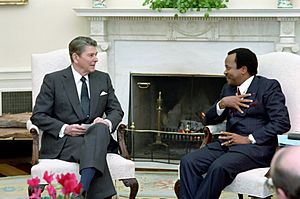
Under Biya's leadership, Cameroon adopted economic plans that involved privatization and reducing government spending. In 1985, the CNU party changed its name to the Cameroon People's Democratic Movement. Biya was re-elected as President of Cameroon on 24 April 1988.
Biya began to open up the political system, leading to the legalization of opposition parties in 1990. He won the first multiparty presidential election on 11 October 1992. The opposition, led by John Fru Ndi, questioned the results.
In the October 1997 presidential election, which was boycotted by major opposition parties, Biya was re-elected with a large majority. He was sworn in on 3 November. He has also been consistently re-elected as the National President of his party, the RDPC.
Biya won another seven-year term in the 11 October 2004 presidential election. He officially received 70.92 percent of the votes. The opposition again claimed there was widespread fraud. Biya was sworn in on 3 November.
The 1996 Constitution had a two-term limit for the president. However, Biya wanted to change this to run again in 2011. In 2008, he said that limiting people's choice was undemocratic. Despite violent protests in February 2008, the National Assembly voted to remove term limits on 10 April 2008. This change also gave the president immunity from prosecution for actions taken while in office.
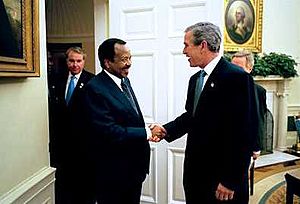
On 12 June 2006, Biya signed the Greentree Agreement with Nigerian president Olusegun Obasanjo. This agreement officially ended the border dispute over the Bakassi peninsula.
In February 2008, riots occurred, with people asking for lower prices and for Paul Biya to leave office. The protests were met with strong force.
In the October 2011 presidential election, Biya won a sixth term. He received 77.9% of the votes. His opponents again claimed widespread fraud. In his victory speech, Biya promised to boost the economy and create jobs. He was sworn in on 3 November 2011.
Biya won the 2018 presidential election with 71.3% of the vote. This election saw some violence and low voter participation. Biya has stated his intention to run for an eighth term in the 2025 Cameroonian presidential election.
Foreign Relations
Relations with France
France, a former colonial power in Cameroon, supports Biya's government. It provides weapons and trains Cameroon's military. France is also the largest foreign investor in Cameroon.
Relations with China
The People's Republic of China and Cameroon established relations on 26 March 1971. Leaders from both countries have visited each other. President Biya visited China in 2006, and Chinese President Hu Jintao visited Cameroon in 2007.
Chinese foreign minister Wang Yi visited Cameroon on 12 January 2014. In June 2020, Cameroon was one of 53 countries that supported the Hong Kong national security law at the United Nations.
Relations with Israel
Cameroon has voted against several anti-Israel UN resolutions. It was the only nation to vote with Israel against a UN resolution on "Assistance to Palestine Refugees."
Cameroon cut ties with Israel from 1973 to 1986 but was one of the first countries to restore relations. Cameroon's Rapid Reaction Force is equipped and trained by Israel. Students from Cameroon have traveled to Israel to learn about agriculture.
Relations with Nigeria
Biya filed a case at the International Court of Justice on 29 March 1994 regarding the Bakassi peninsula. Cameroon's claim was based on a 1913 agreement and a 1975 declaration. Nigeria argued that the peninsula belonged to them.
On 10 October 2002, the court ruled in favor of Cameroon. It told Nigeria to withdraw from the region. Nigeria initially protested, but its government cooperated with the ruling. In June 2006, the countries signed the Greentree Agreement. This agreement required Nigeria to withdraw its troops from Bakassi by 4 August 2008. It also required Cameroon to protect the rights of Nigerian citizens living there. The transfer of the territory happened peacefully.
The UN Secretary-General Kofi Annan created the Cameroon–Nigeria Mixed Commission. This commission helped both countries implement the court's ruling smoothly. The commission's tasks included marking the border and helping with troop withdrawals. As of July 2019, most of the border had been surveyed and agreed upon.
Relations with the United States
Economic relations between Cameroon and the U.S. were very strong in 1982. Biya worked to expand Cameroon's foreign relations even more. He called his foreign policy "diplomacy of development" and "open door" diplomacy.
Since around 2013, relations have focused on fighting terrorism, especially against Boko Haram. Between 2015 and 2020, about 300 U.S. military personnel were in northern Cameroon. They helped with intelligence and surveillance.
Personal Life
Paul Biya became a French citizen when he studied in France. He later gave up his French citizenship when he returned to Cameroon to work in government.
In 1961, he married Jeanne-Irène Biya. She adopted Franck Biya, who was born in 1971. Franck Biya is sometimes seen as a possible future leader. Jeanne-Irène Biya passed away on 29 July 1992. Paul Biya married Chantal Vigouroux on 23 April 1994. They have two children together: Paul Jr and Brenda Biya.
Biya is a Rosicrucian. He was likely part of the Rosicrucian organization CIRCES.
Health
As of 2025, Paul Biya is the longest-serving non-royal head of state. He has been in power since 30 June 1975. Because of his age, people often discuss his health and who might succeed him. In October 2024, the government denied rumors of his death. Officials stated he was in Geneva and in good health. On 9 October, the Minister of Territorial Administration Paul Atanga Nji banned media outlets from discussing the president's health. On 21 October, state television showed Biya arriving back in Cameroon from Switzerland.
See also
 In Spanish: Paul Biya para niños
In Spanish: Paul Biya para niños


